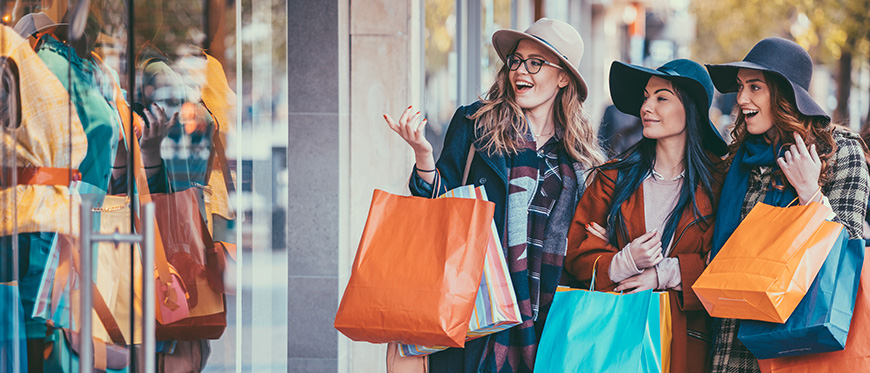There’s no shortage of articles with titles like “Trends in retail design for 2019,” “What’s next in retail design,” “Top in-store design tips for 2019,” and…well, you get the picture. We all want to know the tips and tricks that will keep us a step ahead of the competition for at least one more year.
But following all of those tips can be tricky, and unproductive, if you don’t first concentrate on what’s most important. In retail, whether online or in-store, the most important place to start is with your customer’s experience – and new research shows that the most important determinant of any good retail experience is good design.
Competing with e-commerce by stealing its design secrets
The power of effective design is well recognized in e-commerce, where the intertwined fields of UI (user interface) design and UX (user experience) design have long focused on usability. Simple, intuitively navigated, easy-to-buy-from websites or apps are the ones that sell, sell, sell.
Increasingly, the in-store experience is also being redesigned with simplified usability in mind – but also with likability, comfortability, relatability. In short, with the entirety of a very human experience taken in to consideration.
Color blocking for retail success in-store
The trend toward color blocking is one manifestation of UX design crossing over into the “real world,” to help brick-and-mortar retailers compete. On the simplest level, organizing products by color can be an in-store navigation aid – essentially “color coding” your inventory to help customers differentiate categories and more easily find products. On a deeper level, colors can accentuate the seasonal and emotional appeal of products, functioning as subtle purchase triggers.
Six design characteristics that create an effective retail experience
Fully leveraging the power of design is not, however, to be mistaken as a simple task of putting pretty colors into clever arrangements. Recent research from Gensler, one of the world’s leading experiential design firms, identified six characteristics of in-store design required for delivering the overall experience customers crave.
1. Beauty
It’s a timeless truth: beauty attracts. But, as the classic fashion designer Christian Dior once said, “There is no beauty that is attractive without zest.” And “zest” is what good design must bring to retail spaces, to attract, surprise, and delight consumers, setting a store apart from more mundane competitors, and rewarding consumers for venturing beyond their connected devices.
2. Clarity
The rule here is as simple as your store design should be – keep things clear, well-organized and intuitive. The more a customer struggles to figure out what you’re selling or where to find it, the less you’ll sell.
3. Sense of welcome
In the early days of e-commerce, a common pitch was “Shop at home in the comfort of your pajamas.” As clichéd as that may now seem, customers who are once again getting off the couch and out to the mall still want to feel comfortable. As the report states, “Spaces that feel welcoming and support a diverse community of people are consistently rated as better experiences.”
The upshot is that retail spaces may now include non-selling community spaces, be they social lounges, coffee bars or performance spaces. And because excellent customer service is a huge component in positive customer experience, spaces should also be designed to be enjoyable for employees and accommodating of their needs.
4. Authenticity
Your store design must resonate with your brand’s personality. If you sell fun, affordable fashion, skip the chandeliers and marble – go for creative colors, textures and surprising, even interactive, features.
Your store experience also needs to be consistent with your brand promise. Are you a purpose-driven brand that supports the environment? Then utilize recycled materials, from the wood in your furniture to the paper in your restrooms.
5. Novelty
Is your store in any ways unique? Does its design surprise and delight? Is it interesting enough to get talked about on social media? If not, it may be time to redesign, because boring, me-too environments simply tell customers “you should have stayed home and shopped online.”
6. Inspiration
The research showed that 71% of in-store shoppers didn’t actually come to shop. So why did they come? One big reason: a desire to “stir things up,” to get out into the world and be part of what’s happening, what’s coming, what’s exciting. In other words, to be inspired. This can manifest itself in retail environments that bring nature indoors, provoke new thinking, or provide entertainment…the possibilities are limitless.
The research discovered something else fascinating about those 71% of customers who came out without any intention to shop. If they were indeed inspired – if the store provided the beauty, clarity, novelty, authenticity and sense of home-like welcome that combine for an exceptional in-store experience – then over two-thirds of those previous “non-shoppers” made a purchase once in store.
It’s time every retailer took a good, hard look at their in-store design and the experience it delivers, because design-driven experience is what drives sales today. It is also, arguably, the most important trend for competing with e-commerce in 2019 and beyond.
What’s the state of your retail design?
Sources:
Gensler: The Gensler Experience Index
BrainyQuotes: Quotes on Beauty
DotActiv: Color Block Merchandising
